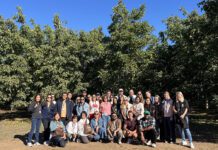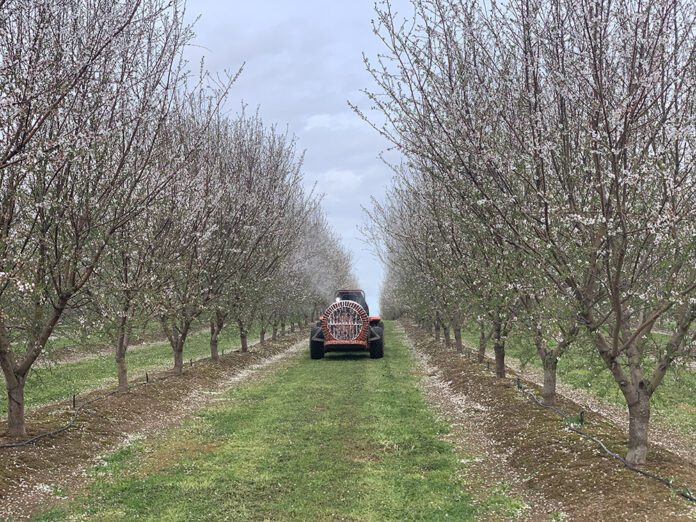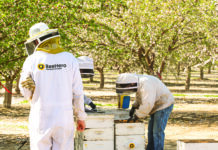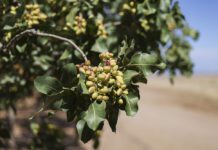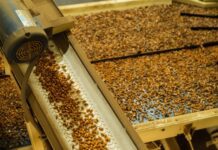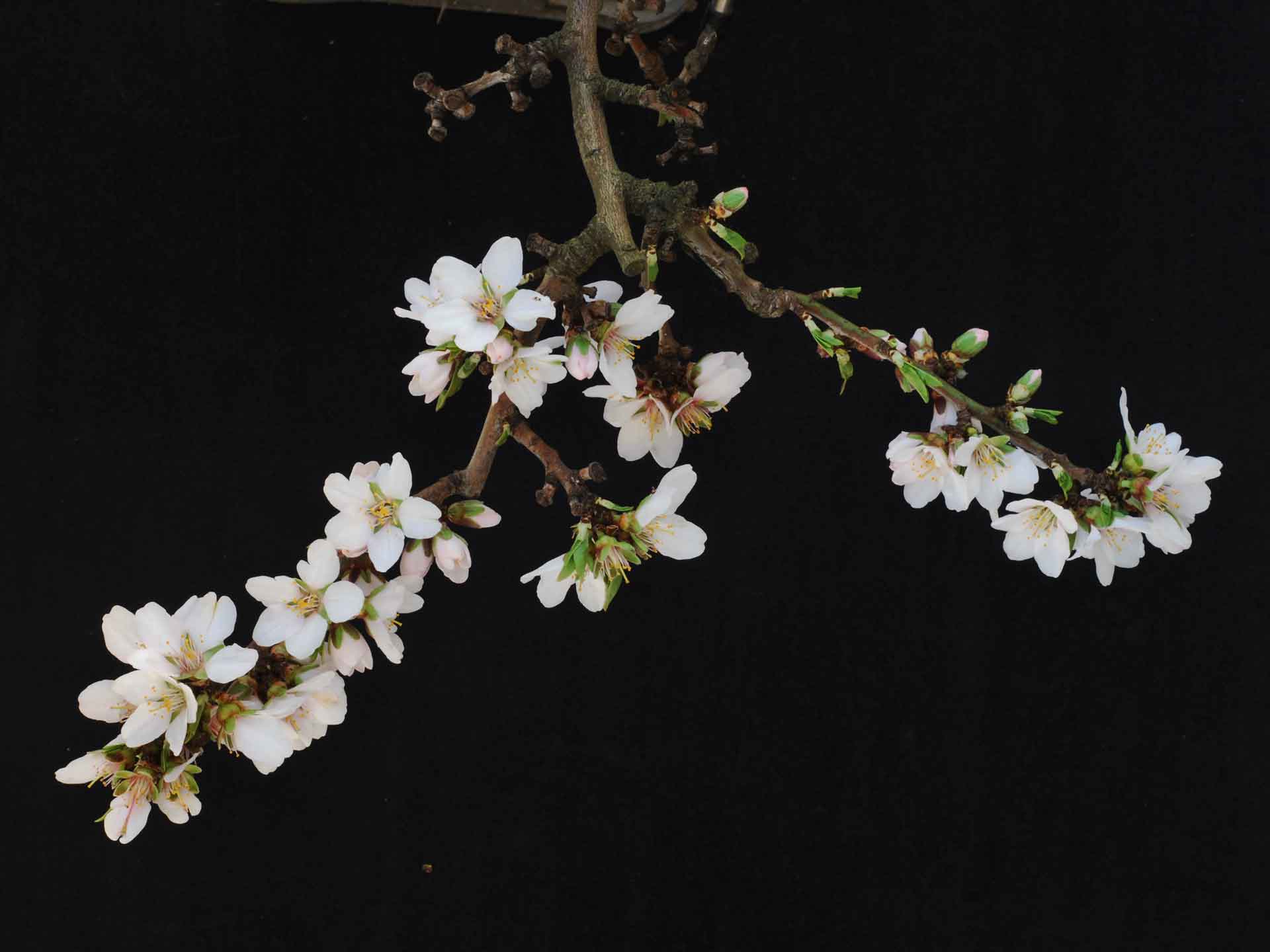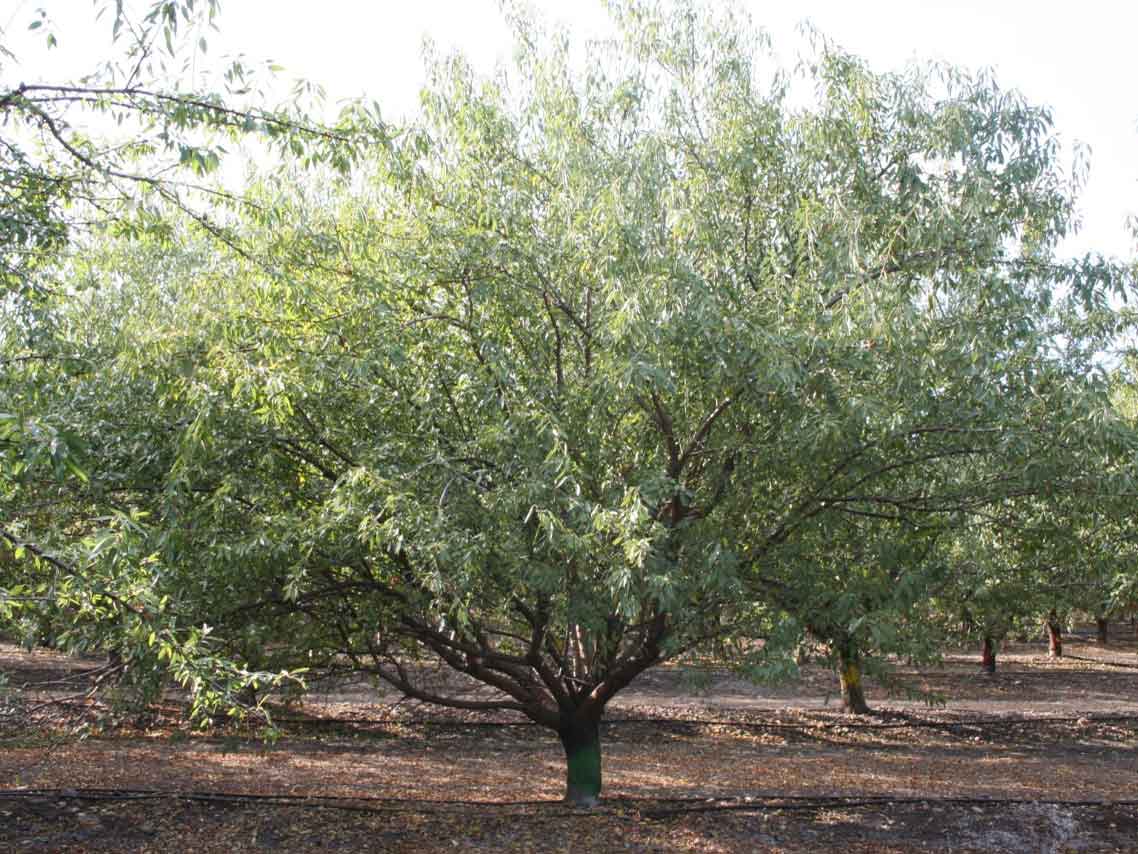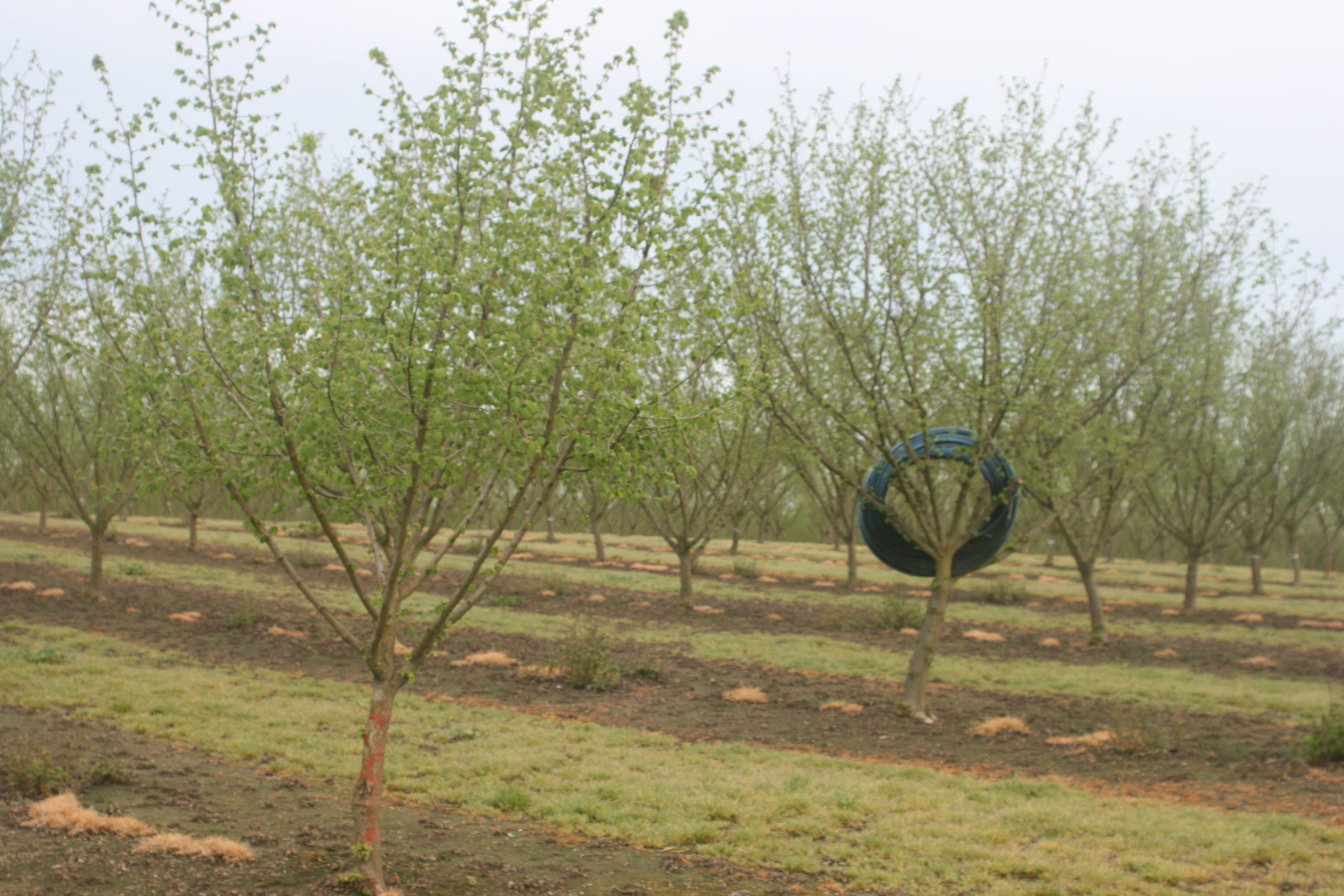Ready or not, here we go again! February is the month when the crop potential is set. Lights on and all hands on deck.
With chilling accumulation or reservoir levels, nothing is final until spring. But checking current levels could be an indication of what’s to come.
So far this year, chilling accumulations around the Sacramento Valley are about the same as 2024; good but less than recent years with great winter chill (2022 and 2023). Especially in the Central and Northern valley, warmer daytime highs have slightly reduced chilling in December and January, usually the best months for chilling.
What does this mean for tree nut growers in the Sacramento Valley? Probably nothing for almonds, which require the least amount of chilling of all the tree crops in the region. However, walnuts and pistachios require significantly more chilling than almonds. What can growers and PCAs do about the possibility of good but not great chilling in walnuts and pistachios this year? For starters, check out the article on this topic for walnuts in last month’s edition of West Coast Nut. The author of that article, Dr. Kat Jarvis-Shean, UCCE orchard advisor in Sacramento, Yolo and Solano Counties, field tested rest breaking materials (Dormex®, etc.) in early March for the last two years with interesting results.
To see current chilling accumulation numbers and those for the past five years, check out the UC Davis Chilling Calculator address in the notes at the end of the column. The Chilling Calculator supports different chilling measurements: Dynamic Model, Utah Model and hours under 45 degrees F. The Dynamic Model is the most accurate model available, according to research.
What about the surface water situation? So far, so good. Shasta and Oroville Lake levels are above average for this time of year. Late November through December showed rapid filling of both reservoirs. Hopefully, the rest of winter and spring will top them off heading into the growing season.
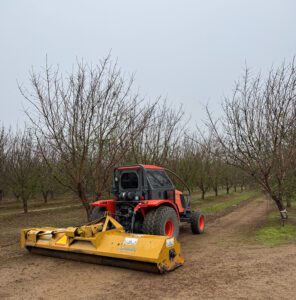
Irrigation
Where irrigation water is available, prep irrigation systems to apply frost protection. Also, plan to measure irrigation distribution uniformity (DU).
Frost
If frost is forecast, start sprinkler irrigation when wet bulb temperature reaches the critical temperature and shut it off only after the wet bulb temperature is above the wet bulb temperature. Firm, bare and moist soil is the warmest, the best for absorbing and holding heat during the day and releasing it at night. Only the top foot of soil needs to be moist to deliver passive frost protection via heat release at night. Running drip irrigation ahead of a frost event to darken the soil and hold daytime heat for release at night may provide some slight increase in temperature.
Bees
Good bee activity in almond orchards at bloom is still critical to successful almond production. Cross-pollination produced 85% of the 2024 almond crop. Growers should do all in their power to keep bees healthy and active. This includes:
• Placing hives where the morning sun reaches them early, allowing hives to warm rapidly and bees to be active as early as possible. Hives should face east or south and be located where there is no flood risk.
• Hives drops should be 0.1 to 0.25 miles apart.
• Making sure clean water is available and that bees have safe landing spots such as burlap bags or old bath towels draped over the container edge, so they can drink without drowning.
• Cover water containers before spraying or replace contaminated water with clean after spraying.
• Maintain open communication with your beekeeper(s) throughout the time bees are on your property. Inform beekeepers at least 48 hours before a planned fungicide application.
• Be very careful with pesticides during bloom to protect bee and hive health. Do not directly spray hives with any material. Wherever possible, spray fungicides after mid-afternoon. By that time, bees should have stripped the day’s pollen from the orchard and pollen won’t be contaminated by evening and night spraying. Only Bt (Dipel, etc.) should be used if an insecticide is needed for worm control (peach twig borer and/or leafrollers) during bloom. Adjuvants should not be used when bees are active.
• Hives should be removed from the orchard when 90% of the flowers in the latest blooming variety in the orchard are at petal fall. After this point, bees will look for new food sources beyond the home orchard and might be at risk of pesticide exposure in those fields.
Pests
The key insect pest practice in February is destroying mummy nuts on the orchard floor with a flail mower. Use a slow tractor speed and check behind the mower after each pass to ensure all nuts are being destroyed. This is relatively straightforward in almonds and walnuts but tougher in pistachios. Specialty mulching machines or basic flail mowers can effectively shred mummies. Lighter units may require slower driving speeds and multiple passes to destroy all the mummies. Leaving intact mummies allows pests (navel orangeworm and/or carpophilus beetle) to survive. Don’t waste the $250/acre spent on mummy shaking, poling and sweeping by not paying full attention to how the $50 mowing job is done. The better the sanitation job (mummy removal and mowing), the better the chances of a good nut quality report from the processor.
Check for scale on last year’s shoot growth in walnuts this month. See the link to spray thresholds in the notes. Talk with your PCA about materials, rates and timings if scale populations exceed the economic thresholds. Avoid using spray oil in dormant walnuts and use oil with caution during delayed dormant.
Diseases
Working with your PCA, plan almond bloom fungicides to match bloom weather conditions. The following information is from the work of Dr. Jim Adaskaveg at UC Riverside:
• If little to no rain falls during bloom, only one fungicide need be applied (at 30% to 50% bloom), and that one spray should include a locally systemic material (FRAC 3, 9 and/or 11).
• If rain falls throughout bloom, two sprays are recommended; one at pink bud (5% bloom) and one at full (80%) bloom.
• If bloom weather is cool and wet, jacket rot will be a major concern. Many FRAC 3 fungicides (Tilt®, Tebucon®, etc.) are ineffective on jacket rot.
• If bloom weather is wet and warm, risk of anthracnose infection rises, beginning at pink bud.
• If frost is forecast consider spraying ahead of the frost to help control bacterial blast. Check with your PCA regarding the status of Kasumin®, the most effective material against blast in UC tests. Copper resistance in the blast pathogen is widespread.
• The UC guide to fungicide efficacy and timing is newly updated for 2025 and available for free from the UC IPM website.
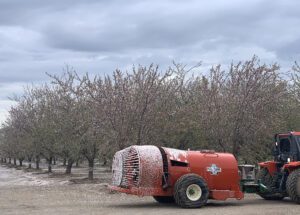
Spray drift
Pre-bloom and bloom are critical times for spray applications in nut crops. These times are also when spray drift risk is highest due to limited canopy. Please review the following points to help reduce spray drift. These practices are also proven to reduce costs by saving diesel and time.
Match your sprayer setup with canopy density to save time and money while delivering effective pest control. With little to no leaf development, spray coverage potential is excellent, so faster ground speeds and 10% to 20% lower RPMs (sprayer or PTO) can deliver effective coverage when using a sprayer sized to work in that orchard. What does that mean? It’s a sprayer that delivers good spray coverage at slow speeds in spring and summer (under full leaf-out conditions) with full RPMs. Adjusting ground speed and power (RPMs) saves money and reduces drift. Check sprayer output (gallons per minute) when increasing ground speed to make sure the spray volume (gallons per acre) stated in the pesticide recommendation is matched. This usually means increasing the number of open nozzles and/or increasing nozzle sizes to get more flow per minute.
Drift risk is greatest near orchard edges, so sprayer operators should be trained/reminded to be particularly careful in those areas and to shut off the sprayer whenever turning on row ends wherever spraying. If you always do it, you always do it. Finally, spraying near public roads should be done early in the morning or late at night. If spraying during daylight hours, have a spotter on site to notify the driver if a vehicle is coming.
Pruning wounds
Treat almond or walnut pruning wounds, especially large cuts, with Topsin-M® (thiophanate methyl) to limit any fungal infection of the wound. If cuts aren’t treated, it’s Russian Roulette with tree health.
Weeds
Talk with your PCA about preemergent herbicide treatments if not applied by this point, but avoid these treatments when hives are in the orchard and if flowers are present in the target strips. Preemergent herbicides are not cheap but offer extended control of problem weeds when properly matched to weed species and carefully applied. Blow leaves from the weed strip ahead of spraying to allow herbicides to reach the soil surface. Good weed control in young orchards is especially important to limit vole activity in tree rows.
Rodents
Keep after gophers and squirrels. Gophers can kill trees by girdling the crown and squirrels can eat profit (nuts). Gopher control in the later winter is a good idea as the breeding season has not started. Combinations of trapping, baiting, or fumigation are more effective than relying on a single practice. Make sure personnel using and/or supervising fumigation are properly certified/licensed. Don’t let gopher populations build in orchards.
Ground squirrel control using fumigants (for trained and licensed personnel) is highly effective in February when used properly and the soil is moist (no cracks that can allow gas to escape from tunnels).
Nutrition
Boron at pink can help improve nut set if not applied in the fall. Only one application is needed between postharvest and full bloom. Boron spraying at full bloom can harm nut set, so fall spraying is preferred as spraying multiple varieties in the same orchard at pink is challenging. Talk with your CCA about effective rates. Too high a boron spray rate can reduce nut set in almond.
No other nutrient applications are needed in February. However, now is the time to decide on the early nitrogen (N) fertilizer rate (applied at full spur leaf out). This application should be 20% of the annual N budget for the orchard. Later N applications can be applied in small amounts every week or two from April into early June. This practice allows more consistent availability of N to the growing nuts and spurs. Check out the Almond Board of California’s Nitrogen BMP publication for more information.
It’s too early to tell how the season will shape up, but here’s to hoping for full reservoirs and good nut prices as the season gets rolling.
Resources
Climate forecast: cpc.ncep.noaa.gov/
Chilling counter: https://fruitsandnuts.ucdavis.edu/chill-calculator
Reservoir levels: https://cdec.water.ca.gov/resapp/RescondMain
Mobile irrigation labs:
• tehamacountyrcd.org/mobile-irrigation-lab
• sutterrcd.specialdistrict.org/mobile-irrigation-lab-367e01c
• yolorcd.org/what-we-do/bilingual-mobile-irrigation-lab/
• https://www.northwestkernrcd.org/
Frost protection with table of critical temperatures: www.sacvalleyorchards.com/almonds/horticulture/frost-protection-2/
Almond Pollination Best Management Practices: www.almonds.com/almond-industry/orchard-management/honey-bee-best-management-practices.
Fungicide Timing and Efficacy: www.ipm.ucanr.edu/agriculture/ (scroll to the page bottom to see the link to the free pub.)
Weed ID: ipm.ucanr.edu/agriculture/almond/Weed-Photo-Gallery-with-common-and-scientific-names/
Monitoring for scale in walnuts: ipm.ucanr.edu/agriculture/walnut/dormant monitoring/
Dormant/delayed dormant practices in pistachio: www.ipm.ucanr.edu/agriculture/pistachio/dormancy-to-delayed-dormancy/
Ground Squirrel Best Management Practices (BMPs): www.groundsquirrelbmp.com/biology.html
Nitrogen BMPs: www.almonds.com/almond-industry/orchard-management/soil-quality-and-nutrients/nutrient-management






